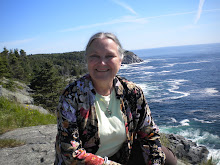I spent five whole days in one place, in Montserrat, up in the hills outside Barcelona. And lo and behold, I started to feel really comfortable there, the way I sometimes do when I go to a retreat center in the "normal" world and spend a few days. I started to know where to find the better cup of coffee, understand which doors to push and which to pull, know which trails led where, and stuff like that. More, some of the staff started to know who I was and exchange pleasantries.
But there was one thing: being in Catalunya is like being in Quebec, only more so. As with French speakers in Quebec, there are people who mainly speak the local language, Catalá, and have a kind of basic grasp of the "other" language, in this case, not English, but Castellano (that´s Spanish, to those of us who are not into emphasizing that Spain has more than one language). So I was walking around, feeling happy and comfortable among all these people whose speech was simply a kind of unknown music flowing by.
It was strange-- the feeling of comfort made me want to speak English with them, and sometimes that was the better choice, because English is also taught in school and has less political baggage than Castellano. The church services were conducted in this alien tongue, so I just let it all wash over me (a good thing, in this case, not to understand what they were saying). Beautiful Gregorian and other chants by the monks who live there. If I had understood better, I might have felt less at home.
Anyway, on St. John´s eve, I went up for the bonfire and the fireworks and learned the steps for the sardana, so I´ve begun my initiation as a Catalan. Now, the language, that´s another story! And the wanting to speak English? Maybe that mainly means it´s time to go home for real.
